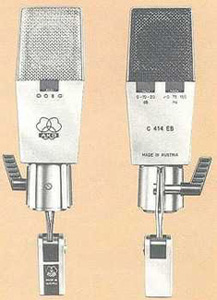Curing Condenser Confusion: An Audio History of The AKG C 414
SonicScoop contributor and producer/engineer Justin Colletti recently launched his audio+music blog, Trust Me, I’m A Scientist and we think it’s rad — be sure to check it out and sign up for the TMimaS newsletter! SonicScoop will periodically publish excerpts and links to the articles we know you will dig (like this one on the AKG C 414 here!). Read on and click through for more…
The AKG C 414 is one of the most important and misunderstood microphones of all time.
The way we count it, this model has had 12 or more incarnations over the past 40 years, each with it’s own idiosyncrasies, and some varying significantly in sound and design.
As AKG tweaked this model, it picked up new bits of circuitry, lost others, and even underwent changes to the capsule, a dramatic alteration that amounts to putting a new set of ears on the microphone. Over the years this versions of this model have been celebrated, derided, and described as both unquestionably bright and inarguably dark. So which is it?
In an effort to clear up some of the confusion, we set out to test all of the major incarnations of this mic side-by-side on the instruments they excel on. Read on and listen for yourself as we attempt to demystify this classic line once and for all.
The History
In the 1930s, Americans and British manufacturers tweaked their dynamic and ribbon microphone designs, while the Germans took steps to perfect the condenser element. Using factories in the cities of Berlin and Gefell, the Neumann company built the microphones that would power German broadcasting during World War II, and later bring unprecedented fidelity to recording studios in the United States.
Demand for this style of microphone grew tremendously in the post-war years, with Telefunken distributing these advanced sound-capture devices throughout the west. But as Neumann’s Geffell factory fell behind the iron curtain, it wasn’t long before the time came for a new designer to get in the game.
In 1953, an Austrian company called AKG revealed the now-legendary CK12 microphone capsule, and became one of the two dominant forces in the manufacture of commercial condenser microphones. This new capsule became be the basis of their bestselling AKG C-12 microphone (rebranded by their distributor as the Telefunken ELAM 251) and eventually, the AKG C-414.
The Sound
While there’s something subtly dapper, masculine, and muscular about the sound of the Neumann mics built around the breakthrough M7 capsule, the sound of AKG’s CK12 capsule occupied the other end of the spectrum. Theirs were mics characterized by their clean, clear midrange and breathtaking high-frequency reproduction.
Neumann’s U47 provided an upper midrange bump that delivered plenty of clarity in its own way, but this model also rolled off slightly in the upper reaches of its frequency response. By comparison, the high-end of the new AKG mics went on for days. They had lower self-noise, and were a leaner, cleaner animal. In many ways the CK12 was the Stratocaster Neumann’s Les Paul, Pepsi to their Coke.
As the transistor revolution swept through the world of electronics, both these companies retooled and miniaturized. As Neumann’s U47 and U67 gave way to the FET 47, U77, and most famously, the U87, AKG got busy designing the solid-state C 412. Soon after its release, they upgraded the mic to allow 4 pickup patterns, and in 1971, the C 414 “comb” was born.
After 5 years, AKG redesigned the body, switched to a more durable “cannon” connector and reworked the mic’s transformer to provide clean, unsaturated low-end reproduction at high levels of volume. These changes yielded the first fully-modern 414, The C 414 EB (1976). And this EB or “Extended Bass” version is where our story really begins.
Dark or Bright?
Its name aside, the original EB model wasn’t characterized by its bass response, but, like the C12, by its take on the high-frequencies.
This mic was outfitted with the same brass-ringed CK12 capsule as the C12. It made for a sound with a neat, tidy midrange, complemented by extended top end which can sound be shimmering, airy, or just subtly bright depending on the age and condition of the capsule.
The 414 EB was a popular mic, competing nicely with Neumann’s new U77 and U87 models. But halfway through the production of this mic, AKG inexplicably changed the way the capsule was made, without changing the name of the microphone.
To many engineers, the change in sound seemed dramatic, and from here on out, the story of the 414 would become mired in confusion.









